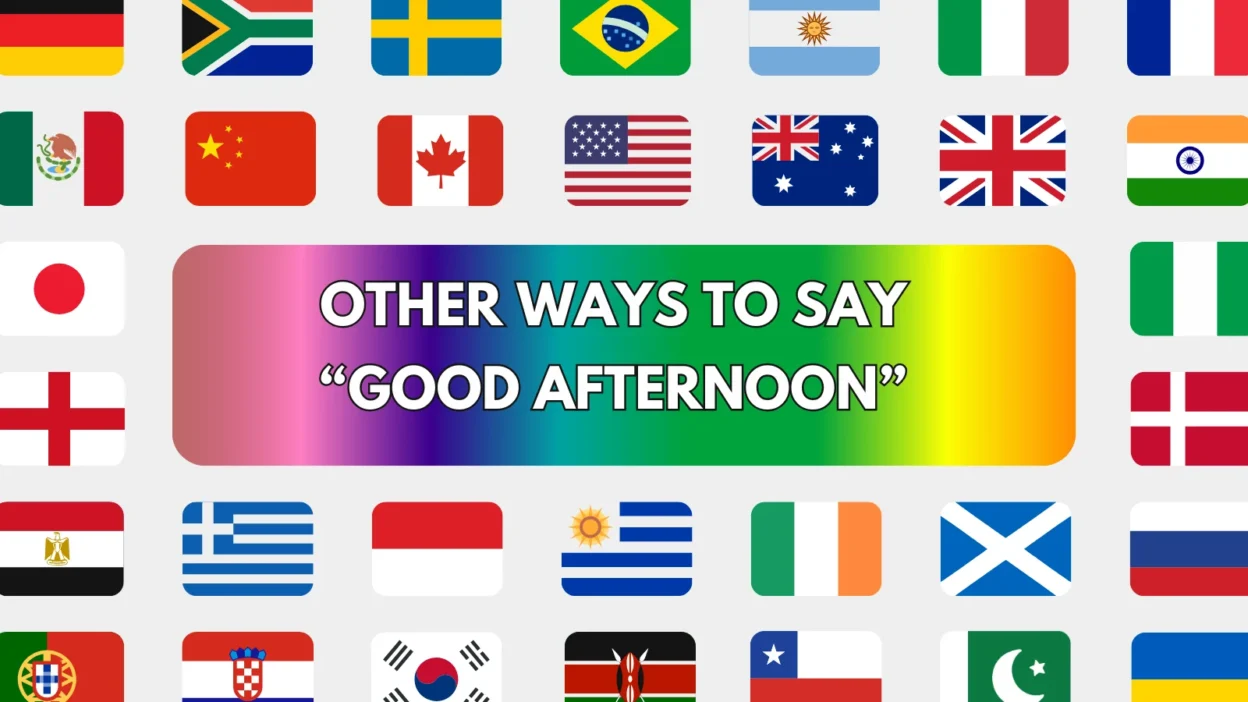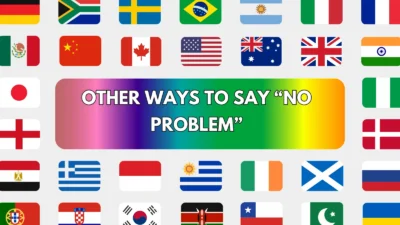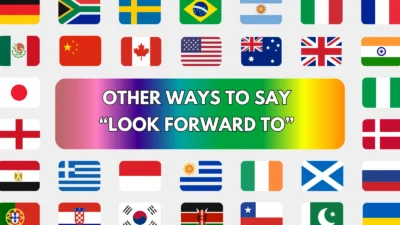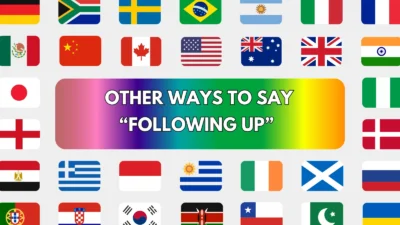“Good Afternoon” is a courteous and common way to greet someone during the midday hours. While it’s perfectly polite and professional, using different alternatives can add variety, show personality, and better fit the tone of your conversation. Whether you’re writing an email, greeting a client, or chatting with a colleague, having a diverse set of options helps you sound more natural and engaging.
Here are 25 alternative ways to say “Good Afternoon” that fit a wide range of situations—from formal meetings to friendly messages.
1. Hope You’re Having a Great Afternoon
Meaning:
A greeting that also expresses well wishes for someone’s current day.
Detailed Explanation:
This adds a positive and caring tone to a standard afternoon greeting.
Scenario Example:
Hi Sarah, hope you’re having a great afternoon! Just following up on the proposal.
Best Use:
Emails, business communication.
Tone:
Friendly, warm.
2. Hello and Happy Afternoon
Meaning:
A cheerful and upbeat way to greet someone midday.
Detailed Explanation:
Combines a friendly “hello” with a lighthearted twist.
Scenario Example:
Hello and happy afternoon! I’ve attached the draft for your review.
Best Use:
Newsletters, team messages.
Tone:
Casual, uplifting.
3. Wishing You a Pleasant Afternoon
Meaning:
A formal, thoughtful way to extend midday greetings.
Detailed Explanation:
Great for more professional or client-facing contexts.
Scenario Example:
Wishing you a pleasant afternoon, Mr. Kumar. Please find the contract attached.
Best Use:
Business emails, formal greetings.
Tone:
Polite, professional.
4. Good Day
Meaning:
A neutral and timeless greeting used throughout the day.
Detailed Explanation:
Slightly old-fashioned but still professional and versatile.
Scenario Example:
Good day, team. Here are the updated minutes from the meeting.
Best Use:
Formal emails, international communication.
Tone:
Neutral, respectful.
5. Hope Your Day Is Going Well
Meaning:
A general check-in on someone’s well-being.
Detailed Explanation:
More personal than “Good Afternoon” while still appropriate in many settings.
Scenario Example:
Hope your day is going well! I wanted to confirm our meeting for 3 PM.
Best Use:
Professional follow-ups, customer service.
Tone:
Polite, thoughtful.
6. Afternoon!
Meaning:
A casual and quick way to say “Good Afternoon.”
Detailed Explanation:
Great for relaxed communication, especially in chat or informal emails.
Scenario Example:
Afternoon! Just a heads-up, I’ll be in late tomorrow.
Best Use:
Team chats, internal messages.
Tone:
Informal, friendly.
7. Lovely Afternoon to You
Meaning:
A charming and pleasant way to greet someone midday.
Detailed Explanation:
Adds a bit of warmth and personality to your tone.
Scenario Example:
Lovely afternoon to you! I enjoyed our conversation earlier.
Best Use:
Friendly emails, personal messages.
Tone:
Charming, warm.
8. I Hope Your Afternoon Is Treating You Well
Meaning:
A light and friendly expression to wish someone a nice day.
Detailed Explanation:
Conveys a casual interest in how their day is going.
Scenario Example:
I hope your afternoon is treating you well — any updates on the budget?
Best Use:
Client check-ins, warm follow-ups.
Tone:
Friendly, conversational.
9. How’s Your Afternoon Going?
Meaning:
A direct question about someone’s midday experience.
Detailed Explanation:
Good for starting a conversation or breaking the ice.
Scenario Example:
Hi John, how’s your afternoon going? Just wanted to ask about the next steps.
Best Use:
Chat messages, informal communication.
Tone:
Casual, personable.
10. Warm Afternoon Greetings
Meaning:
A polite and formal way to say hello during the afternoon.
Detailed Explanation:
Adds warmth and etiquette to a professional message.
Scenario Example:
Warm afternoon greetings! Please see the attached meeting notes.
Best Use:
Client emails, official letters.
Tone:
Professional, kind.
11. Wishing You a Wonderful Day Ahead
Meaning:
A forward-looking expression of well-wishes.
Detailed Explanation:
Suitable when messaging in the later part of the afternoon.
Scenario Example:
Wishing you a wonderful day ahead. Let me know if you need anything else.
Best Use:
Closing lines, polite replies.
Tone:
Encouraging, courteous.
12. Good to See You This Afternoon
Meaning:
Acknowledges a midday meeting or conversation.
Detailed Explanation:
Great for follow-up emails or in-person greetings.
Scenario Example:
Good to see you this afternoon — let’s keep in touch about the next phase.
Best Use:
Meeting recaps, follow-up notes.
Tone:
Gracious, appreciative.
13. What a Beautiful Afternoon!
Meaning:
An exclamation celebrating the pleasant time of day.
Detailed Explanation:
Adds cheer and positivity to your greeting.
Scenario Example:
What a beautiful afternoon! Perfect time for a quick coffee chat?
Best Use:
Casual chats, friendly notes.
Tone:
Cheerful, upbeat.
14. It’s a Great Afternoon to Connect
Meaning:
Ties your greeting to a purpose like networking or collaborating.
Detailed Explanation:
Good for meetings, intros, or outreach emails.
Scenario Example:
It’s a great afternoon to connect. I’m looking forward to learning more about your work.
Best Use:
Professional intros, networking.
Tone:
Polite, enthusiastic.
15. Sending You Good Vibes This Afternoon
Meaning:
A modern, friendly way to wish someone well.
Detailed Explanation:
Fun and casual — adds a human touch.
Scenario Example:
Sending you good vibes this afternoon! Let me know how the meeting goes.
Best Use:
Team chats, informal support.
Tone:
Playful, positive.
16. Good Midday to You
Meaning:
An alternative to “Good Afternoon” focused on the middle of the day.
Detailed Explanation:
Uncommon but still polite and understandable.
Scenario Example:
Good midday to you! Ready for our 2 PM call?
Best Use:
Creative messaging, internal chats.
Tone:
Unique, friendly.
17. Hope This Afternoon Brings You Peace and Productivity
Meaning:
Wishes someone a calm and effective afternoon.
Detailed Explanation:
Especially nice for thoughtful emails or after meetings.
Scenario Example:
Hope this afternoon brings you peace and productivity — best of luck with the tasks ahead.
Best Use:
Personal encouragement, follow-ups.
Tone:
Supportive, motivating.
18. Midday Greetings!
Meaning:
A creative and short greeting to replace “Good Afternoon.”
Detailed Explanation:
Short and sweet while still sounding professional.
Scenario Example:
Midday greetings! Just checking in on the delivery schedule.
Best Use:
Emails, meeting intros.
Tone:
Friendly, professional.
19. Sunshine and Smiles to You This Afternoon
Meaning:
A bright and cheerful greeting to lift someone’s spirits.
Detailed Explanation:
Ideal for uplifting messages and casual check-ins.
Scenario Example:
Sunshine and smiles to you this afternoon! Just wanted to say hi.
Best Use:
Positive messages, team chats.
Tone:
Playful, kind.
20. I Hope the Rest of Your Afternoon Goes Smoothly
Meaning:
Wishes the person a trouble-free day ahead.
Detailed Explanation:
Great for wrapping up a conversation or email.
Scenario Example:
Thanks again for the update. I hope the rest of your afternoon goes smoothly.
Best Use:
Client support, email closings.
Tone:
Polite, calm.
21. Happy Midday!
Meaning:
A quick and joyful greeting for the middle of the day.
Detailed Explanation:
Similar in tone to “Happy Monday,” it’s informal and lighthearted.
Scenario Example:
Happy midday! Got time to review the proposal?
Best Use:
Internal communication, casual outreach.
Tone:
Cheerful, informal.
22. Trust You’re Having a Nice Afternoon
Meaning:
A formal way to open communication while expressing goodwill.
Detailed Explanation:
Ideal for clients, vendors, or formal messages.
Scenario Example:
Trust you’re having a nice afternoon. Kindly find attached the signed agreement.
Best Use:
Business letters, vendor emails.
Tone:
Professional, courteous.
23. Warmest Greetings This Afternoon
Meaning:
A very polite and elegant way to say “Good Afternoon.”
Detailed Explanation:
Adds a refined and respectful touch to your email.
Scenario Example:
Warmest greetings this afternoon. I appreciate your time on today’s call.
Best Use:
Diplomatic or executive communication.
Tone:
Elegant, respectful.
24. A Joyful Afternoon to You
Meaning:
Wishing someone happiness during the afternoon hours.
Detailed Explanation:
Ideal for optimistic, cheerful messaging.
Scenario Example:
A joyful afternoon to you! Let’s connect before 4 PM if possible.
Best Use:
Creative messages, event invites.
Tone:
Lighthearted, happy.
25. May Your Afternoon Be Productive and Peaceful
Meaning:
A wish for both efficiency and calm.
Detailed Explanation:
Combines encouragement with warmth, perfect for midday check-ins.
Scenario Example:
May your afternoon be productive and peaceful — talk soon!
Best Use:
Emails, support messages.
Tone:
Balanced, supportive.
Conclusion
While “Good Afternoon” is polite and effective, having a wide range of alternative greetings adds personality and relevance to your messages. These 25 thoughtful options allow you to adapt your tone to match your relationship, setting, and intention — whether you’re being warm, formal, cheerful, or casual.




